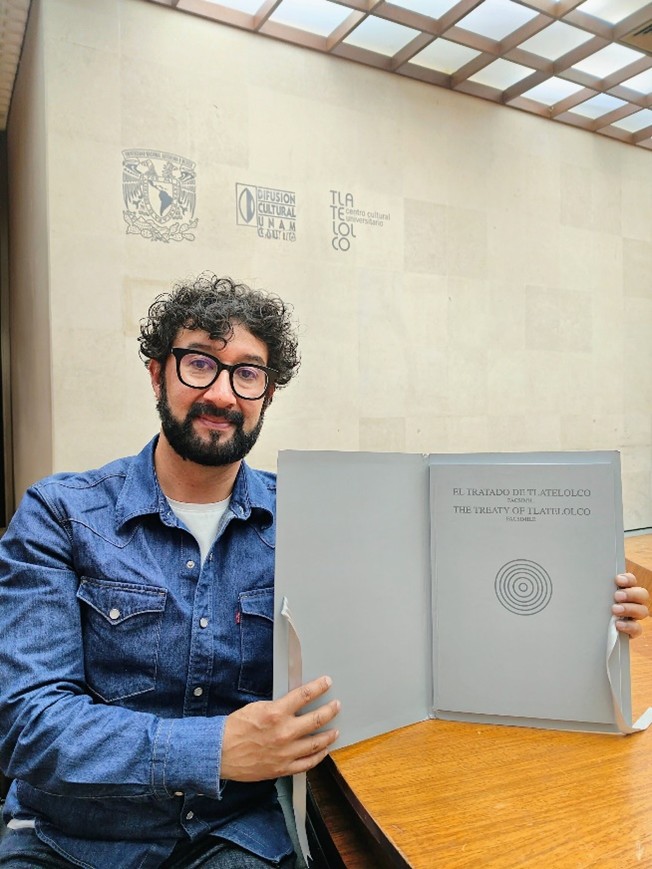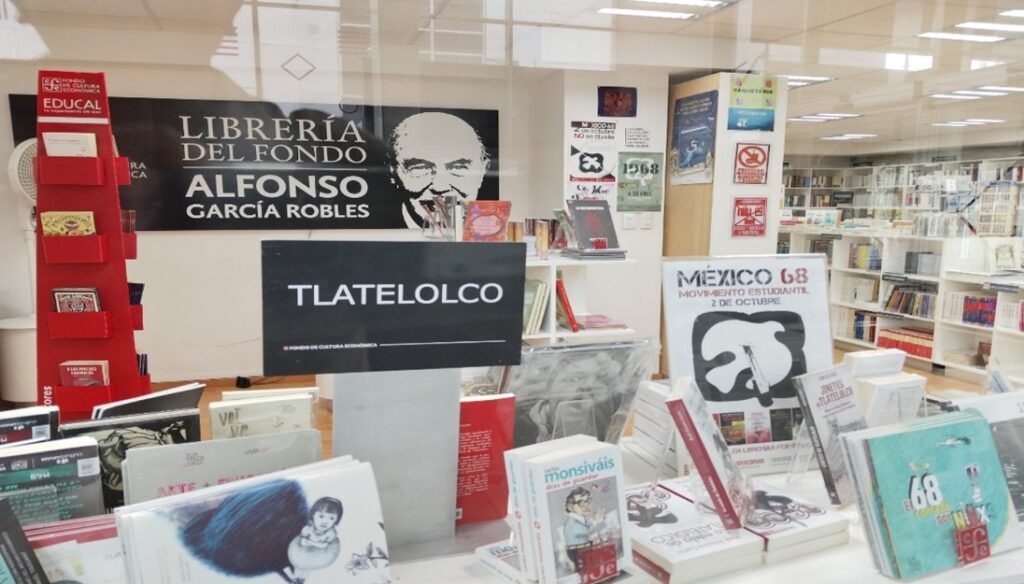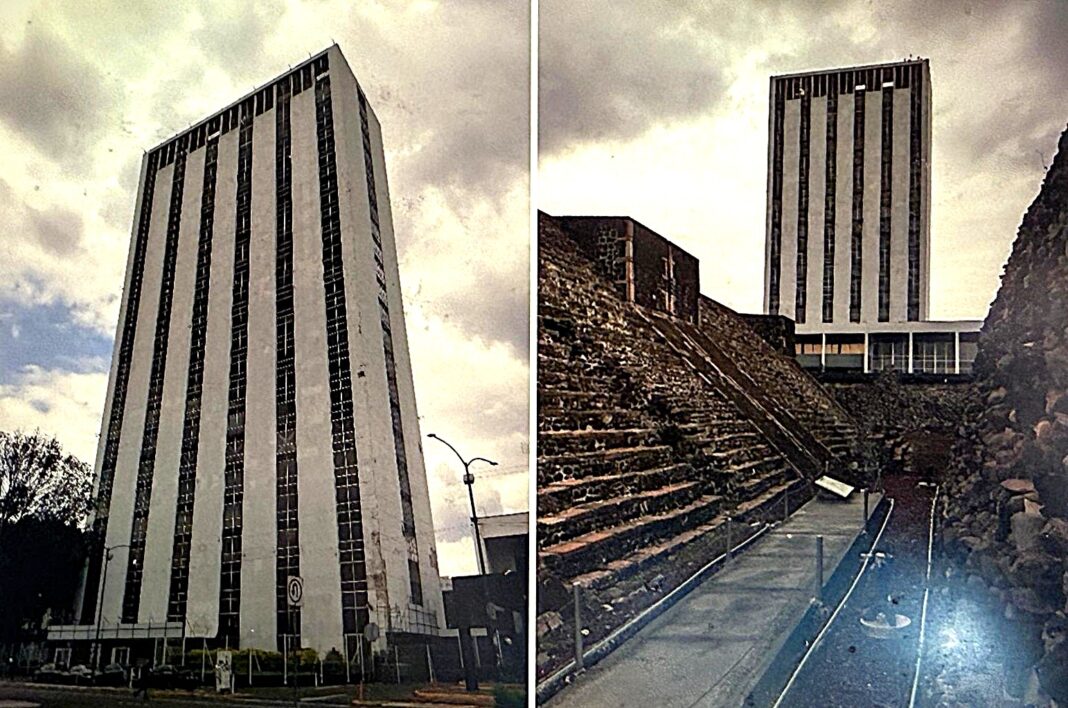Inspired by the United Nations headquarters, the building was the epicenter of Mexican diplomacy for almost forty years. It was there that one of the most important chapters in the fight against nuclear weapons was written in 1967, with the signing of the Treaty of Tlatelolco.
By Guillermo Ayala Alanis
Mexico City (INPS Japan) – To speak of Tlatelolco is to speak of history. This site, located in northern Mexico City, blends past and present represented by three cultures: pre-Hispanic, colonial, and contemporary. It is a place marked by death and, at the same time, by the guarantee of life. Here there has been war and peace, trade and evangelization, modernity and repression, resilience, diplomacy, and the struggle for nuclear non-proliferation. |JAPANESE|SPANISH|
A 22- floor tower dominates the landscape of Tlatelolco. For almost 40 years—from 1966 to 2005—it housed the Ministry of Foreign Affairs (Secretaria de RE in Spanish). Today it is the Tlatelolco University Cultural Center (CCUT in Spanish), a space dedicated to preserving the memory of this emblematic neighborhood. “Spaces have echoes; walls tell us how architecture is steeped in history. This building is proof that the diplomatic sphere in this area of Mexico City was very important in a decade that required a presence,” said Roberto Barajas Chávez, CCUT Visual Arts Coordinator, in an interview with INPS Japan.
In the 1960s, the Mexican government sought to concentrate the country’s diplomatic activity, which was then scattered across several buildings, in a single location. Tlatelolco was chosen, where the newly inaugurated Nonoalco-Tlatelolco housing complex stood out as a symbol of progress and a showcase for the prosperity that Mexico wanted to show the world. The SRE tower was inaugurated in 1966 and immediately became the epicenter of Mexico’s foreign policy.
From this new place, then-Foreign Minister Alfonso García Robles promoted a historic event: The Treaty for the Prohibition of Nuclear Weapons in Latin America and the Caribbean, better known as the Treaty of Tlatelolco. Signed on February 14, in 1967, it made the region the first Nuclear-Weapon-Free Zone in the world. Its relevance was enormous in the midst of the Cold War, when the planet was living under the threat of an unprecedented war between the United States and the Soviet Union that almost took Latin America and the Caribbean as its battleground, in the episode known as the 1962 missile crisis.
“This dispute, which seemed bipolar, was actually global because it affected everyone. The important thing is that the Treaty of Tlatelolco continues to resonate today; international organizations such as OPANAL remind us of this,” said Roberto Barajas.
The SRE tower was designed by architect Pedro Ramírez Vázquez. Its white marble facade and dark glass windows, standing 102 meters tall, symbolize “cleanliness and verticality,” values that Mexican foreign policy sought to reflect. The structure was inspired by the UN headquarters in New York, both in its rectangular shape and in the interior layout of corridors, auditoriums, offices, and meeting rooms.

With the beginning of the new millennium, in 2006, the SRE moved its offices to downtown Mexico City, leaving the tower in Tlatelolco vacant. The building had withstood the 1985 earthquake, although it had suffered structural damage. In 2007, the National Autonomous University of Mexico (UNAM) took control of the building and transformed it into the Tlatelolco University Cultural Center, dedicated to the dissemination of art and the preservation of historical memory.
Today, the site houses two permanent exhibition halls. The first tells the pre-Hispanic history of Tlatelolco, founded in 1337 as a mirror city of Mexico-Tenochtitlan and key to trade between the region’s populations. The second is dedicated to the student movement of 1968, when on October 2, the army, on the orders of then-President Gustavo Díaz Ordaz, brutally repressed students from the UNAM and other institutions of higher education. This room commemorates the victims and the context of repression at the time.
Although there is no permanent room dedicated exclusively to the Treaty of Tlatelolco, the CCUT keeps its memory alive. In 2025, it presented the exhibition Tlatelolco: Epicenter of Nuclear Disarmament and Feminism, which commemorated the 58th anniversary of the signing of the treaty and the 50th anniversary of the First World Conference on Women, held in 1975 in the same tower.

“The soul of this building was diplomatic and an architectural innovation. Engaging with the past is not just about recovering memory, but rethinking the present and even thinking about the future,” explains Barajas. That is why many CCUT exhibitions seek to link architecture and politics.

The memory of Ambassador Alfonso García Robles, winner of the 1982 Nobel Peace Prize for his promotion of nuclear disarmament, also lives on. The main auditorium and a bookstore on the premises bear his name. In that bookstore, there is a painting that seems to watch over the literature on the historical events of Tlatelolco, such as the student movement of 1968.
The old room where the Treaty of Tlatelolco was signed has been adapted to current needs. That large hall, where Mexican diplomats showed visitors from other friendly nations the fusion of the three cultures that gave rise to contemporary Mexico, is now used for temporary exhibitions and events. However, a smaller space in the CCUT recreates what the main hall looked like during those historic negotiations that showed the world that Latin America was capable of working toward the non-proliferation of nuclear weapons.

In addition to exhibitions and conferences, the Tlatelolco University Cultural Center organizes concerts, workshops, and community activities that strengthen ties with neighboring neighborhoods. Its goal is to connect local history with new generations and help residents recognize themselves as part of a legacy that combines resistance, culture, and diplomacy.
On September 19, Tlatelolco commemorated the victims of the earthquake that shook Mexico City 40 years ago. In the Nonoalco-Tlatelolco multifamily complex, that modern symbol of 1960s Mexico, the Nuevo León building was destroyed and other buildings suffered less catastrophic damage, including the SRE Tower, which will celebrate its 60th anniversary in 2026. The Tlatelolco University Cultural Center is already preparing for the festivities.
This article is brought to you by INPS Japan in collaboration with Soka Gakkai International, in consultative status with the UN’s Economic and Social Council (ECOSOC).
INPS Japan




